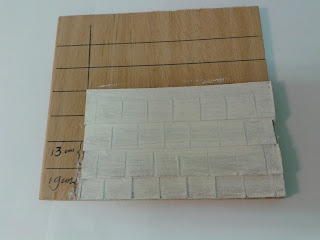The living room just needed a cosy couch and easy chair. But I hesitated; would I make these pieces of furniture myself or would I just buy them....
I had made some furniture in the past using a helpful Dutch doll's house guide, named;
"Interieurs voor poppenkamers" (written by H. van Eck and published by Cantecleer)
Unexpecxtedly, I happened to find two lovely pieces of furniture in the shop of "Karweipost".
I very much liked the shape of it. But colour and pattern of the fabric didn't match with the wallpaper of my miniature- livingroom.
I decided to buy them anyway and change their uphostery to my own taste, bearing in mind the handy tricks I had learned from the small guide mentioned above.
I started off with the yellow armchair and then went on with the couch.
First of all I carefully stripped the couch of all it's upholstery, making sure no to damage the pieces of foam, which later would be still useful beneath the new wrapping.
As you can see in the picture; I made paper templates of several wooden parts of the couch. I also added foam to the armpieces, to give the couch a real soft and cosy appearence.
I wrapped the wooden parts, one after the other, with the cloth of my choise. I used Tacky Glue and a few nails to make sure the couch would not fall apart again.
I removed the original legs of the furniture. Instead I painted 4 pieces of nicely shaped wooden parts and split all 4 of them in half. In this way I ended up with 8 nice parts to use as legs. Doing so I could also adjust the height of the furniture to my liking. Using glue and nails I attached the small legs to the armchair and couch.
The finishing touch consisted of hiding small gaps by adding ribbon and piping, using Tacky Glue.
And how nicely they fit into the room!
































